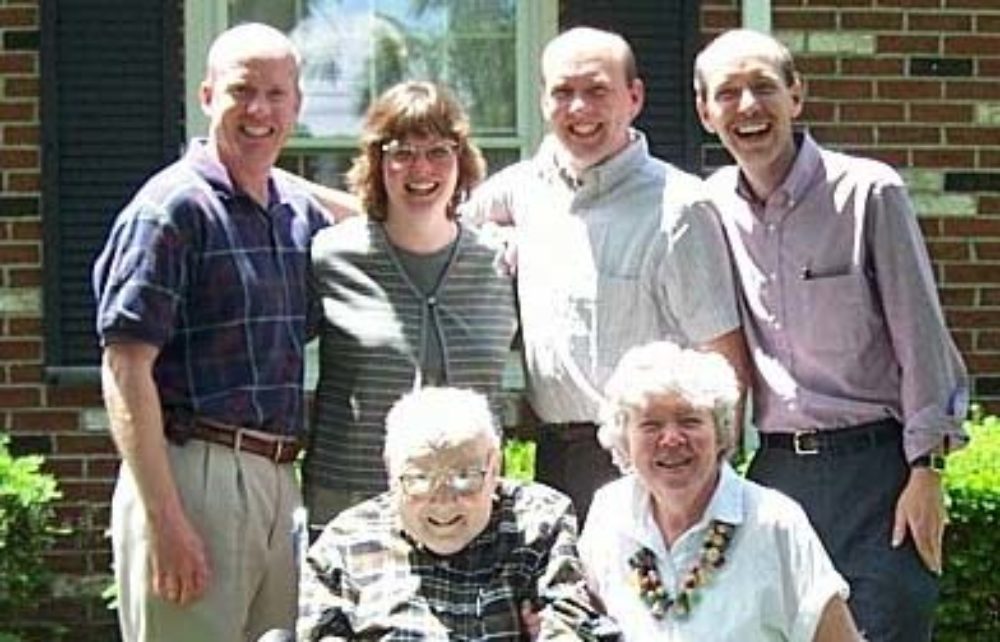Thad’s recollection (with a few comments from Steve) of the swampland near 1005 Gustin, provided by both guys after a request from Alexis for a college class assignment:
1. Life prior to swamp being filled in: It was a boy’s paradise! Paul Johnson’s dad had lots of spare lumber as a carpenter/builder, so I remember the rectangular “boats” that were built, and we would pole around in the swamp. There was also a crude treehouse or two put up in the trees that rose up out of the swamp area, so we would eat lunch up there, and try to come up with ways to make it inaccessible to others (pounded in footholds at tough heights, angles, etc.). In the winter we would ice skate on it, and play hockey games. I remember taking saws out there to cut off small trees/branches at ice level, to try and give us more playing space. In the field space that surrounded the swamp, we would dig huge underground forts, covered in plywood, with dirt thrown back over the ceiling to conceal the “fort”. Don’t remember just what we did down there! Riding our mini bikes out in those fields was another highlight for me, along with playing in “jungleland”, which was its own oasis, separated from the swamp by perhaps 100 yards. It was just a few trees, bushes, and some big rocks, but it felt like its own environment. We would also pull weeds that came with large clumps or dirt, so we could launch dirty bombs at each other in a form of combat. Wow, the memories are flooding in! And yes, there were the occasional brush fires that we liked to build, connecting one pile to the other through a series of connecting dried grass… We played in the swamp, enjoying time with boats in “the 6 foot” and collecting little tadpoles from the banks. I felt like we were in the wilderness only a few hundred yards from our house!
2. Life after swamp filled in: When construction began, I remember plotting to build large holes, so the bulldozers would fall into them, and scare off the contractors. I guess none of that occurred. Can’t remember dwelling on it too much beyond that, but I’m sure we enjoyed playing in the dirt that came with the new homes being built in that area. We still had the empty lot across from Grandma’s house, so we continued to use it for apple wars (sharpened ends of sticks, picked up fallen apples from the trees in the lot, and launched apples at one another with the sticks), football games, baseball/whiffleball, archery, and anything else we could imagine….We were bummed when hearing that the swamp area was going to be developed for houses. It seemed amazing that they’d try to put homes in that area but they hauled in a bunch of fill (dirt and ???) and then the houses went up. Our wilderness was gone but we still had plenty of great neighborhood fun afterwards.
3. Change to neighborhood after: Neighbor kids were growing up, but we still played fun games like neighborhood chase, cutting through yards, etc.
4. Last memory of swamp: Not sure I have one final memory back there… At some point over the years, a bike trail got created by kids riding from Belleville (neighborhood where homes were built on the west end of town, separated by the fields we played in), cutting through the field to get to the dead-end portion of Gustin, two houses down from Grandma’s house. We considered them intruders into “our” turf!
5. Witness the changes?: I don’t remember seeing the swamp get filled in, but I remember seeing all the homes being built throughout the field. It was a sad time in my life, but we had so many other funs things to do that we just had to move on.
Some additional comments, these from Andy…
I’d point out, however, that “the swamp” was actually part of the famous Black Swamp, which is documented wonderfully at the museum at Maumee Bay State Park (that park has sections that resemble quite closely what our swamp once looked like); that muskrat used to thrive in our swamp, as well as frogs (both of which would ultimately been hunted to extinction by the Johnson boys and others, who loved to “gig” the frogs — blech); and that I share the sense of a huge loss when the swamp was destroyed for housing. We didn’t know what we were losing (and neither did the city). If that piece of swamp had been preserved, it would have been a wonderful tourist attraction (as well as mosquito breeding ground).
Thad mentioned the tree house(s), and I’ve taken a very important lesson in life from one of those tree houses. Paul Johnson and I spent a lot of time making one of them really wonderful. Several days in row we spent our time out there, maybe over a period of weeks. It was perfect. Then one day I returned to find it ruined (destroyed by Paul Johnson, among others!). How hard it is to make something really wonderful, and how quickly it can be destroyed. A swamp takes a thousand years to “build”, and is destroyed by bulldozers in a week, so effortlessly; species take millions of years to develop their own identities, and we are destroying them at a phenomenal rate, so effortlessly….
